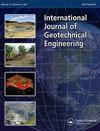Data-driven modeling of ultimate load capacity of closed- and open-ended piles using machine learning
IF 1.3
Q2 ENGINEERING, GEOLOGICAL
International Journal of Geotechnical Engineering
Pub Date : 2023-04-21
DOI:10.1080/19386362.2023.2251795
引用次数: 0
Abstract
Field pile load tests are fairly expensive experiments that can be applied to certain pile types required to be installed in full scale. Hence, it is neither practical nor efficient to perform a load test for every installed pile. While there exist many empirical relations for predicting pile capacities, such methods typically suffer from accuracy and generality. Therefore, current geotechnical practice still looks for methods to accommodate full-scale pile load testing to serve as accurate and practical tools. In this study, load bearing capacities of closed- and open-ended piles in cohesive and cohesionless soils are predicted using machine learning. Nine such methods are utilized in the analyses where Cone Penetration Test (CPT) and pile data are considered as the learning features necessary to teach those methods the database gathered via a comprehensive search. Then, machine learning models are developed, and the databases are separated into five-folds according to the cross-validation-principle, which are used for both training and testing of the machine learning methods. Model predictions are validated with classical CPT-based equations. Results indicate that Relevance Vector Regression and the Random Forest methods typically generate considerably better predictions than the other methods and empirical equations. Thus, machine learning methods are found as reliable tools to predict the pile load capacities of both open-ended and closed-ended pile provided that there is a large enough database and that an appropriate method is used.基于机器学习的封闭式和开放式桩基极限承载能力数据驱动建模
现场桩荷载试验是相当昂贵的试验,可以应用于需要全尺寸安装的某些类型的桩。因此,对每一桩进行荷载试验既不实际也不有效。虽然预测桩基承载力存在许多经验关系,但这些方法通常存在准确性和通用性的问题。因此,目前的岩土工程实践仍在寻找适合全尺寸桩荷载测试的方法,以作为准确实用的工具。在本研究中,使用机器学习预测了粘性和无粘性土壤中封闭式和开放式桩的承载能力。在分析中使用了九种这样的方法,其中锥突测试(CPT)和桩数据被认为是通过全面搜索收集的数据库所必需的学习特征来教授这些方法。然后,建立机器学习模型,并根据交叉验证原则将数据库分成五层,用于机器学习方法的训练和测试。用经典的基于cpt的方程验证了模型预测。结果表明,相关向量回归和随机森林方法通常比其他方法和经验方程产生更好的预测。因此,只要有足够大的数据库并使用适当的方法,机器学习方法可以作为预测开放式和封闭式桩的桩载能力的可靠工具。
本文章由计算机程序翻译,如有差异,请以英文原文为准。
求助全文
约1分钟内获得全文
求助全文
来源期刊

International Journal of Geotechnical Engineering
ENGINEERING, GEOLOGICAL-
CiteScore
5.30
自引率
5.30%
发文量
32
 求助内容:
求助内容: 应助结果提醒方式:
应助结果提醒方式:


